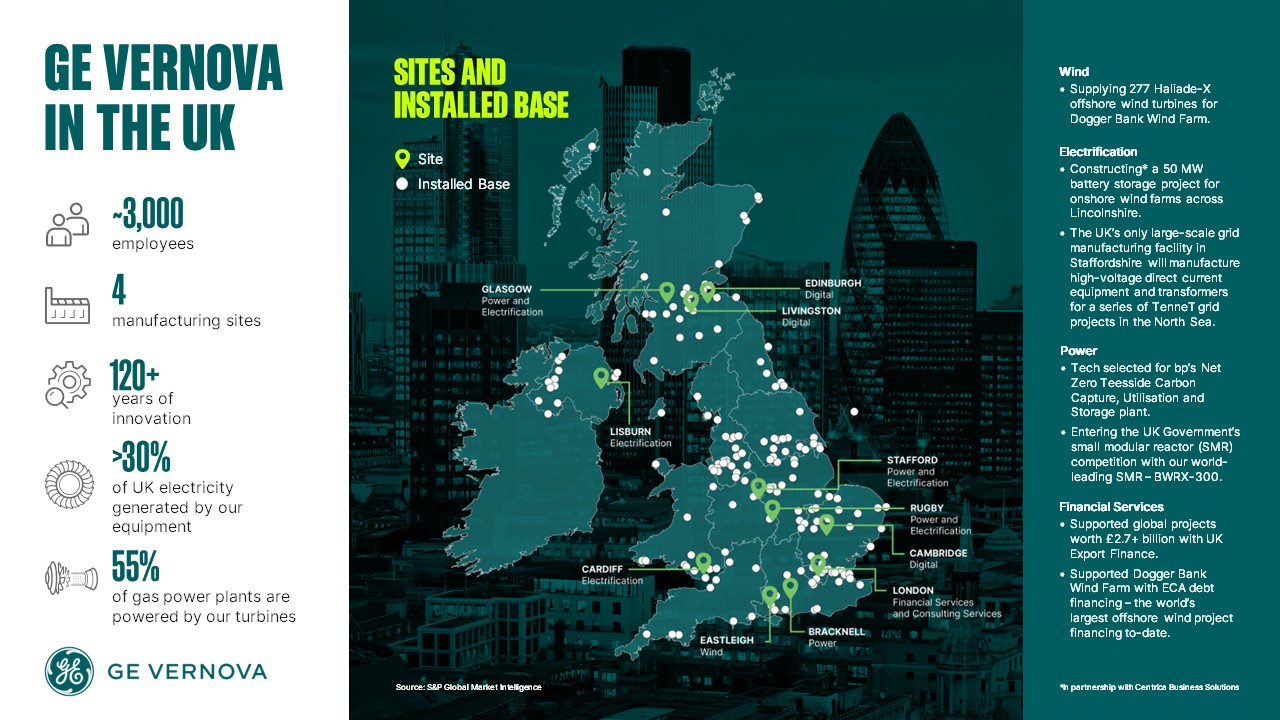The United Kingdom acknowledges that nuclear power must be an important part of a complex, multi-faceted energy solution intended to meet the challenge of creating a net-carbon-zero electricity grid.
Emission-free nuclear
UK nuclear revival helps bring about energy independence
The UK’s electricity grid is in a state of transition as Parliament has set the ambitious goal of cutting the nation’s greenhouse gas emissions to zero by 2050. With much of its current nuclear fleet fast-approaching end-of-life, modern innovations like GVH’s BWRX-300 small modular reactor (SMR) promise to help the UK deliver on its net-carbon-zero promise and become energy independent.
SMR benefits
Smarter, safer, faster, more economical
GVH’s BWRX-300 represents the latest evolution of the economic simplified boiling water reactor (ESBWR). Melding proven ESBWR technology with advanced construction solutions and innovative building techniques results in a SMR that is smarter, safer, faster to construct, and less costly to operate.
Frequently asked questions
Certainty comes with experience
Do GE Vernova and GE Vernova Hitachi have a presence in the UK?
With more than 3,000 employees at 11 UK sites and more than 100 years of experience, GE Vernova has deep roots in—and a strong commitment to—the UK. In fact, 35% of UK electricity is generated on GE Vernova equipment, as the graphic below illustrates.
GE Vernova Hitachi—which is part of GE Vernova—has been present in the UK for decades, and added a UK Country Leader, UK Project Director, and UK Licensing Manager (see the bottom of this page) in 2024. We plan to build upon this core team significantly through the Future Nuclear Enabling Fund (FNEF), Generic Design Assessment (GDA), and Great British Nuclear SMR program.

Is nuclear power a clean energy technology?
Nuclear’s carbon footprint is miniscule compared to fossil fuels. In fact, if all the world’s coal and natural gas plants were replaced with low-carbon nuclear, global CO2 emissions would be reduced by nearly 13 billion tons annually.
Does the UK use nuclear power now?
Yes! There are nine operating commercial nuclear power reactors at five nuclear generating stations in the UK which, in 2022, produced 5.9 GWe—approximately 16% of the UK’s electricity. However, at its peak capacity in 1997, 26% of the UK’s electricity came from nuclear energy. Four of those reactors are slated for closure by the year 2030.
Will a nuclear power plant take up a large amount of land?
Nuclear is already the most land-efficient means of electricity production, requiring only 2.4 km²/TWh per year. However, an SMR like the GE Vernova Hitachi BWRX-300 is also designed to reduce building volume in plant layout by about 90 percent, resulting in a minimal impact on natural habitats compared to fossil fuels.
Is nuclear power safe?
Many countries have safely used nuclear power for well over 60 years. It is one of the most closely monitored and regulated industries in the world and actually has the lowest rate of fatalities and injuries per unit of electricity compared to all other electric power generation. The latest cybersecurity systems and well-trained on-site security personnel provide around- the-clock security.
The reactors themselves are built to strident safety specifications, constantly monitored, and layered with multiple redundancy systems to maintain the unprecedented track record of safety the industry has achieved.
How is the nuclear energy industry regulated in the UK?
The Office for Nuclear Regulation (ONR) is the UK’s nuclear regulator. It is an independent agency with legal authority to regulate nuclear safety, civil nuclear security and safeguards, and—at authorized defense sites—conventional health and safety at the licensed British nuclear sites.
The ONR ensures that security arrangements are adequate for dealing with special nuclear material and information. It also regulates the transportation safety and security of civil nuclear and radioactive materials by road, rail, and inland waterways.

Blog
Driving UK energy resilience with the BWRX-300 SMR
Andrew Champ, UK Country Leader at GE Vernova Hitachi Nuclear Energy, highlights the BWRX-300 small modular reactor (SMR) as a cost-effective, safe, and reliable solution to boost UK energy resilience, create jobs, drive local growth, and support net-zero goals with proven, scalable low-carbon technology.
White paper
Reaching net-zero carbon in Great Britain
Learn how Britain can deliver the quickest and deepest emission reduction—and achieve its objective of climate neutrality by 2050 while producing the lowest possible cumulative emission over the transition period—by using an effective combination of technologies, including nuclear power.
Recent developments
UK nuclear news
Regional experts
Meet the team
With our cross-business resources, we're able to serve a diverse global client base with a strong local presence in markets around the world.
Regions
Learn more about GVH’s impact around the world
Contact us

 Cymraeg (Welsh)
Cymraeg (Welsh) 








